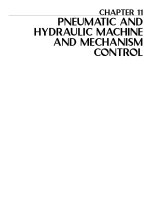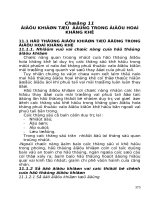20200131 sitrep 11 ncov
Bạn đang xem bản rút gọn của tài liệu. Xem và tải ngay bản đầy đủ của tài liệu tại đây (782.76 KB, 8 trang )
Novel Coronavirus(2019-nCoV)
Situation Report - 11
Data as reported by 31 January 2020*
HIGHLIGHTS
•
•
•
The Emergency Committee on the novel coronavirus (2019-nCoV) under the
International Health Regulations (IHR 2005) was reconvened on 30 January. WHO
declared the outbreak to be a public health emergency of international concern.
The Emergency Committee has provided advice to WHO, to the People’s Republic
of China, to all countries, and to the global community, on measures to control
this outbreak. The Committee believes that it is still possible to interrupt virus
spread, provided that countries put in place strong measures to detect disease
early, isolate and treat cases, trace contacts, and promote social distancing
measures commensurate with the risk. More details can be found here and in
Annex to this situation report.
Today, the first two confirmed cases of 2019-nCoV acute respiratory disease were
reported in Italy; both had travel history to Wuhan City.
WHO’s Risk Communication Team has launched a new information platform
called WHO Information Network for Epidemics (EPI-WIN). EPI-WIN will use a
series of amplifiers to share tailored information for specific target groups. EPIWIN began this week to establish connections to health care and travel and
tourism sectors and will work with food and agriculture and business/employer
sectors next week.
SITUATION IN NUMBERS
Globally
9826 confirmed
China
9720 confirmed
15238 suspected
1527 severe
213 deaths
Outside of China
106 confirmed
19 countries
WHO RISK ASSESSMENT
China
Regional Level
Global Level
Very High
High
High
Figure 1. Countries, territories or areas with reported confirmed cases of 2019-nCoV, 31 January 2020
*The situation report includes information reported to WHO Geneva by 10 AM
TECHNICAL FOCUS:
Research and innovation
As part of WHO’s response to the outbreak, the R&D Blueprint has been activated to accelerate evaluation of the
diagnostics, vaccines and therapeutics for this novel coronavirus
The global imperative for research is to maintain a high-level discussion platform which enables consensus on
strategic directions, nurtures scientific collaborations and, supports optimal and rapid research to address crucial
gaps, without duplication of efforts.
Understanding the disease, its reservoirs, its transmission, its clinical severity and developing effective counter
measures including therapeutics and vaccines is critical for the control of the outbreak, the reduction of related
mortality and minimization of economic impact.
Recent reports regarding expert research consultations can be found here />
SURVEILLANCE
Table 1. Countries, territories or areas with reported confirmed cases of 2019-nCoV, 31 January 2020
WHO Regional Office
Country/Territory/Area
Confirmed Cases
China*
9720
Japan
14
Republic of Korea
11
Viet Nam
5
Singapore
13
Australia
9
Malaysia
8
Cambodia
1
Philippines
1
Thailand
14
Nepal
1
Sri Lanka
1
India
1
United States of America
6
Canada
3
France
6
Finland
1
Germany
5
Italy
2
Eastern Mediterranean
United Arab Emirates
4
Total Confirmed cases
Total
Western Pacific
South-East Asia
Region of the Americas
European Region
9826
*Confirmed cases in China include cases confirmed in Hong Kong SAR (12 confirmed cases), Macau SAR (7 confirmed cases) and
Taipei (9 confirmed cases).
Figure 2: Epidemic curve of 2019-nCoV cases (n=62) identified outside of China, by date of onset of symptoms and
travel history, 31 January 2020
Note for figure 2: Of the 106 cases reported outside China, seven were detected while asymptomatic. For the
remaining 99 cases, information on date of onset is available only for the 62 cases presented in the epidemiologic
curve.
Figure 3: Epidemic curve of 2019-nCoV cases (n=106) identified outside of China, by date of reporting and travel
history, 31 January 2020
STRATEGIC OBJECTIVES
WHO’s strategic objectives for this response are to:
•
•
•
•
•
•
Limit human-to-human transmission including reducing secondary infections among close contacts and
health care workers, preventing transmission amplification events, and preventing further international
spread from China*;
Identify, isolate and care for patients early, including providing optimized care for infected patients;
Identify and reduce transmission from the animal source;
Address crucial unknowns regarding clinical severity, extent of transmission and infection, treatment
options, and accelerate the development of diagnostics, therapeutics and vaccines;
Communicate critical risk and event information to all communities and counter misinformation;
Minimize social and economic impact through multisectoral partnerships.
*This can be achieved through a combination of public health measures, such as rapid identification, diagnosis
and management of the cases, identification and follow up of the contacts, infection prevention and control in
healthcare settings, implementation of health measures for travellers, awareness- raising in the population and
risk communication.
PREPAREDNESS AND RESPONSE
•
•
•
•
•
•
•
•
•
•
WHO has actively sought misinformation and responded to rumours through ‘myth busting’ on WHO’s social
media and its website.
WHO has developed a protocol for the investigation of early cases (the “First Few X (FFX) Cases and contact
investigation protocol for 2019-novel coronavirus (2019-nCoV) infection”). The protocol is designed to gain an
early understanding of the key clinical, epidemiological and virological characteristics of the first cases of 2019nCoV infection detected in any individual country, to inform the development and updating of public health
guidance to manage cases and reduce potential spread and impact of infection.
WHO has been in regular and direct contact with Member States where cases have been reported. WHO is also
informing other countries about the situation and providing support as requested.
WHO has developed interim guidance for laboratory diagnosis, advice on the use of masks during home care and
in health care settings in the context of the novel coronavirus (2019-nCoV) outbreak, clinical management,
infection prevention and control in health care settings, home care for patients with suspected novel
coronavirus, risk communication and community engagement.
Prepared disease commodity package that includes an essential list of biomedical equipment, medicines and
supplies necessary to care for patients with 2019-nCoV.
WHO has provided recommendations to reduce risk of transmission from animals to humans.
WHO has published an updated advice for international traffic in relation to the outbreak of the novel
coronavirus 2019-nCoV.
Activation of R&D blueprint to accelerate diagnostics, vaccines, and therapeutics.
WHO has developed an online course to provide general introduction to emerging respiratory viruses, including
novel coronaviruses.
WHO is providing guidance on early investigations, which are critical to carry out early in an outbreak of a new
virus. The data collected from the protocols can be used to refine recommendations for surveillance and case
definitions, to characterize the key epidemiological transmission features of 2019-nCoV, help understand spread,
severity, spectrum of disease, impact on the community and to inform operational models for implementation of
•
•
countermeasures such as case isolation, contact tracing and isolation. The first protocol that is available is a:
Household transmission investigation protocol for 2019-novel coronavirus (2019-nCoV) infection.
WHO is working with its networks of researchers and other experts to coordinate global work on surveillance,
epidemiology, modelling, diagnostics, clinical care and treatment, and other ways to identify, manage the
disease and limit onward transmission. WHO has issued interim guidance for countries, updated to take into
account the current situation.
WHO is working with global expert networks and partnerships for laboratory, infection prevention and control,
clinical management and mathematical modelling.
RECOMMENDATIONS AND ADVICE FOR THE PUBLIC
During previous outbreaks due to other coronavirus (Middle-East Respiratory Syndrome (MERS) and Severe
Acute Respiratory Syndrome (SARS), human-to-human transmission occurred through droplets, contact and
fomites, suggesting that the transmission mode of the 2019-nCoV can be similar. The basic principles to reduce
the general risk of transmission of acute respiratory infections include the following:
•
•
•
•
•
Avoiding close contact with people suffering from acute respiratory infections.
Frequent hand-washing, especially after direct contact with ill people or their environment.
Avoiding unprotected contact with farm or wild animals.
People with symptoms of acute respiratory infection should practice cough etiquette (maintain distance, cover
coughs and sneezes with disposable tissues or clothing, and wash hands).
Within healthcare facilities, enhance standard infection prevention and control practices in hospitals, especially in
emergency departments.
WHO does not recommend any specific health measures for travellers. In case of symptoms suggestive of respiratory
illness either during or after travel, travellers are encouraged to seek medical attention and share their travel history
with their healthcare provider.
ANNEX 1: Temporary Recommendations under the International Health Regulations
associated with the declaration of the outbreak of 2019-nCoV as a Public Health
Emergency of International Concern
To the People’s Republic of China
Continue to:
• Implement a comprehensive risk communication strategy to regularly inform the population on the evolution of
the outbreak, the prevention and protection measures for the population, and the response measures taken for its
containment.
• Enhance public health measures for containment of the current outbreak.
• Ensure the resilience of the health system and protect the health workforce.
• Enhance surveillance and active case finding across China.
• Collaborate with WHO and partners to conduct investigations to understand the epidemiology and the evolution of
this outbreak and measures to contain it.
• Share relevant data on human cases.
• Continue to identify the zoonotic source of the outbreak, and particularly the potential for circulation with WHO as
soon as it becomes available.
• Conduct exit screening at international airports and ports, with the aim of early detection of symptomatic travelers
for further evaluation and treatment, while minimizing interference with international traffic.
To all countries
It is expected that further international exportation of cases may appear in any country. Thus, all countries should be
prepared for containment, including active surveillance, early detection, isolation and case management, contact
tracing and prevention of onward spread of 2019-nCoVinfection, and to share full data with WHO. Technical advice is
available on the WHO website.
Countries are reminded that they are legally required to share information with WHO under the IHR.
Any detection of 2019-nCoV in an animal (including information about the species, diagnostic tests, and relevant
epidemiological information) should be reported to the World Organization for Animal Health (OIE) as an emerging
disease.
Countries should place particular emphasis on reducing human infection, prevention of secondary transmission and
international spread, and contributing to the international response though multi-sectoral communication and
collaboration and active participation in increasing knowledge on the virus and the disease, as well as advancing
research.
The Committee does not recommend any travel or trade restriction based on the current information available.
Countries must inform WHO about travel measures taken, as required by the IHR. Countries are cautioned against
actions that promote stigma or discrimination, in line with the principles of Article 3 of the IHR.
The Committee asked the Director-General to provide further advice on these matters and, if necessary, to make
new case-by-case recommendations, in view of this rapidly evolving situation.
To the global community
As this is a new coronavirus, and it has been previously shown that similar coronaviruses required substantial efforts
to enable regular information sharing and research, the global community should continue to demonstrate solidarity
and cooperation, in compliance with Article 44 of the IHR (2005), in supporting each other on the identification of
the source of this new virus, its full potential for human-to-human transmission, preparedness for potential
importation of cases, and research for developing necessary treatment.
Provide support to low- and middle-income countries to enable their response to this event, as well as to facilitate
access to diagnostics, potential vaccines and therapeutics.
Under Article 43 of the IHR, States Parties implementing additional health measures that significantly interfere with
international traffic (refusal of entry or departure of international travellers, baggage, cargo, containers,
conveyances, goods, and the like, or their delay, for more than 24 hours) are obliged to send to WHO the public
health rationale and justification within 48 hours of their implementation. WHO will review the justification and may
request countries to reconsider their measures. WHO is required to share with other States Parties the information
about measures and the justification received.









